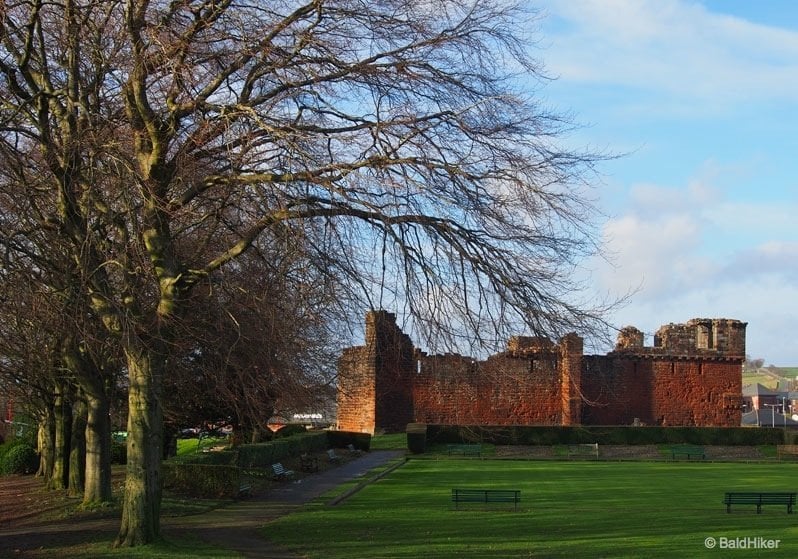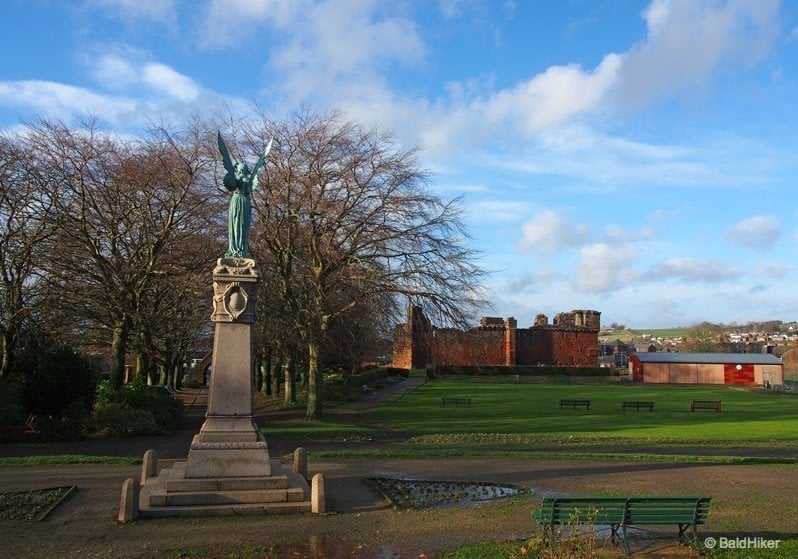If you have ever entered Penrith, Cumbria, from the M6 via the A592, you may have noticed that opposite the main railway station sits a set of sandstone ruins. The ruins of Penrith Castle, within Penrith Castle Park.
Today they are a small ruin, sat upon a hill above the town of Penrith, part of a park with leisure and spare time activities. These small ruins though are packed more history than many people know.

Down the road I had taken a look at a castle with a very different history, Brougham Castle. Here though, a little further North from there in Penrith itself, a different set of sandstone ruins tell a very different story.
Penrith Castle History
Way back in the 13th and 14th Century the English kings, especially Edward I, took it upon themselves to try and take over and rule a very independent and resistive Scotland.
On the Scottish side you have legendary names like Robert the Bruce and The Scots became frequent raiders of Northern England, coming over the border with tens of thousands of men, leaving death and destruction of much livestock and buildings in their wake.

Towards the end of the 13th Century castles and towers where erected by the English in Northern England to help combat and protect from these raids.
Cumberland and Westmorland started with what locally are called Pele Towers. Single square towers with lookouts and defensive roofs.
The Pele Tower at Penrith became the foundation of what was to become the grander Penrith Castle.

Ralph Neville, the 1st Earl of Westmorland made the castle bigger and stronger as part of his job to keep the Scots out.
Richard III at Penrith Castle
In 1471 the castle was granted to Richard, Duke of Gloucester. The man that would go on to become Richard III, the future and last Plantagenet king.
Richard was given the task of of keeping the Scots out as part of his role as Sheriff of Cumberland. He expanded the castle and turned it into more of a grand residence where he stayed and made home many times until 1485.


Since those days the centuries of time and neglect has left us with the ruins we see today. Even in the middle of the 16th Century were written notes talking about the castle being a ruin.
In the Civil War it was used for a short period by the Parliamentarian General John Lambert but from then on it slowly decayed to what we see today. With stone also being taken to help build local farmhouses at times.
A lot of the walls though do stand at their original height. A stone reminder of life hundreds of years ago, looking out over a modern Cumbrian town.

Penrith Castle Park
Of course, the castle and moat is not the only thing to explore within the Castle Park. There are gardens, tennis courts, bowling greens, crazy golf and more.

Flowerbeds ready for spring and summer colour, trees lining the paths. The old bandstand sitting in the centre.

Quite a dramatic monument that takes a central point is the Black Angel Memorial, remembering those that fought and died in the Boer War.


Each visit brings sights of families, dog walkers, and curious sight seeing people, all taking in some fresh air and maybe looking back over 700 years to a very different time indeed, when the castle was in its prime..

Conclusion
It is not so often you get a building, no matter how ruinous, with so much history sitting in a public park and freely accessible.
A Grade I listed building that has some unique history to go with it.
It is free to visit and although the Penrith Castle ruins are worthy of a full day out, it is definitely worth a visit if in the area for sure.
further historical places from this area:
Pendragon Castle – Romantic ruin of Mallerstang









These bring back memories, because I studied travel journalism in Carlisle and often went to Penrith during my 3 years in Cumbria! I’ve always associated seeing Penrith Castle from the train on the way North with a comforting sign that you’re almost home.
ahhh yes.. across from the train station 🙂 thank you
Stunning castle ruins, thanks for sharing these photos!
Hi Charlie. Thanks
Interesting. It looks very different to Edward’s castles in Wales and the Welsh Marches.